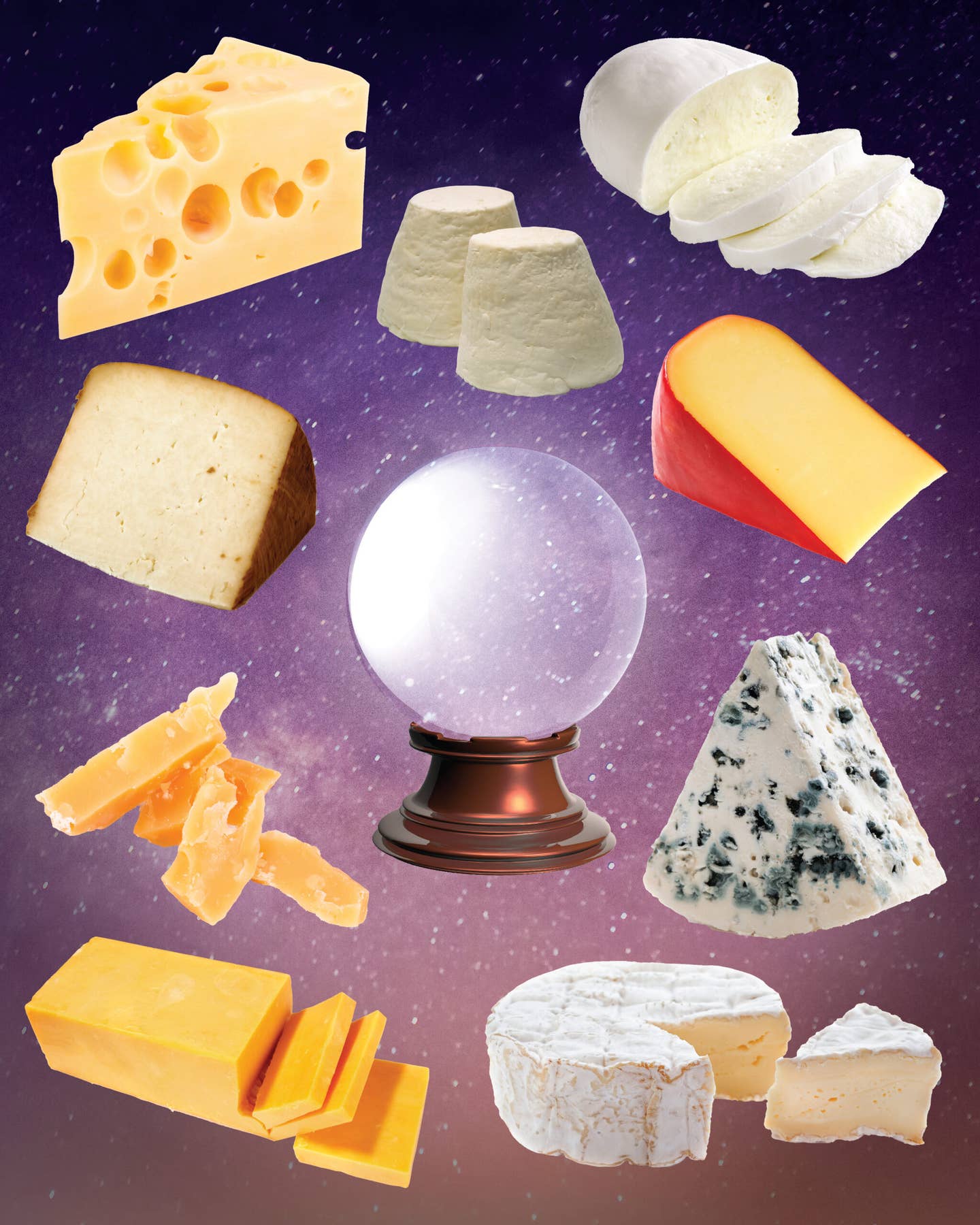The Un-Brie-Lievable History of Tyromancy
This fortune-telling practice uses cheese to predict everything from your future spouse to your next career move.

A few months ago, I told a chef in Vancouver that he would soon experience major growth in his career and take on much more responsibility, and that the letter B would somehow be involved. How did I know? Some cheese told me. He’d been standing next to a particularly veiny piece of blue cheese, and asked me to read his fortune from it. Predicting the future using cheese is something I do as a side business, and from what I can tell, there aren’t very many of us doing this anymore.
This isn’t some cheesy divination method I just made up. Tyromancy, or the practice of telling fortunes with cheese, was first officially mentioned in the second century in the writings of Greek historian and professional diviner Artemidorus of Daldis (also known as Artimedorus of Ephesus) on dream interpretation. He apparently didn’t think cheese was a great invention: he noted at the time that the food signifies “trickery and ambushes” and that tyromancers sullied the work of true diviners like sacrificers and liver examiners. Tyromancers, he argued, were more in league with those who practiced evil types of divination, including dice diviners and necromancers. It feels like a bit of a leap to go from cheese to death, but Artimedorus had some opinions, I guess.
Tyromancy reached peak popularity in England during the Middle Ages and early modern period (1500–1800). The country was primarily an agrarian society at the time, with most families having some sort of livestock that produced milk for cheese—and people loved to dabble in the paranormal. Christianity was ingrained in most people, so looking for insight into one’s predestined future, or trying to find a way to gain control over it, led to widespread interest in divination. One used whatever tools were on hand to achieve that, and at that particular point in history, that meant cheese. It was a much more convenient choice than previous divination methods, which included dumping a ladle of molten lead into a bucket of water to see what shapes it made.
People used cheese to divine all sorts of things: who committed a crime, whether the year would bring a fruitful harvest, and how a child’s life would turn out. Those who practiced it generally used farmer’s cheese, though some tried it with runnier options, like fondue.
Back then, a typical use for tyromancy was to determine who you would marry. You’d simply carve the names of all potential suitors into some pieces of cheese, then wait to see which one molded first. And there it was—your life partner! People also analyzed the number and size of holes in a block of cheese, the patterns of the mold and veins, and the shapes that curds made as they coagulated. The process is similar to that of reading tea leaves or coffee grounds—you tell a story through the shapes you see. A heart shape, for example, signifies love and happiness, while an odd number of holes predicts that something negative might happen.
During the early modern years, tyromancy’s popularity began to wane. After the 1920s, cheese fortune-telling essentially disappeared—perhaps in part due to the swift rise of tarot after the invention of the well-known Rider-Waite deck in 1909. Save for occasional pop-culture references, like in the video game series “The Witcher” and “Baldur’s Gate”, tyromancy became largely unknown.
Today, tyromancy still lingers in the realm of obscurity, though I’m trying to change that by leading workshops and one-on-one sessions to teach people how to read their own cheese. Since launching these classes during the pandemic, they’ve been selling out, which I attribute in part to the popularity of WitchTok and the general feelings of uncertainty created by COVID-19.
In the years I’ve been tyromancing, I’ve figured out ways to read just about any type of cheese. Those with patterns on the surface are best, but you can always break a chunk in half and analyze the variations along the break. You can also use crumbles by dumping them out on a plate. I’ve even read a fortune from a Kraft Singles slice—but the person for whom I was reading had to tear it up and drop it onto a plate first. Vegan cheese? No problem.
That’s probably the biggest way tyromancy has changed between the second century and the present: our world of cheese is so vast now, and every piece of it can tell a story.
After I finished my divination session with that chef in Vancouver, he came around the table to hug me and take a photo. Apparently he had been planning a career move: opening his own eponymous restaurant. Unbeknownst to me, his last name starts with a B, just as the cheese foretold.
Keep Reading
Continue to Next Story










